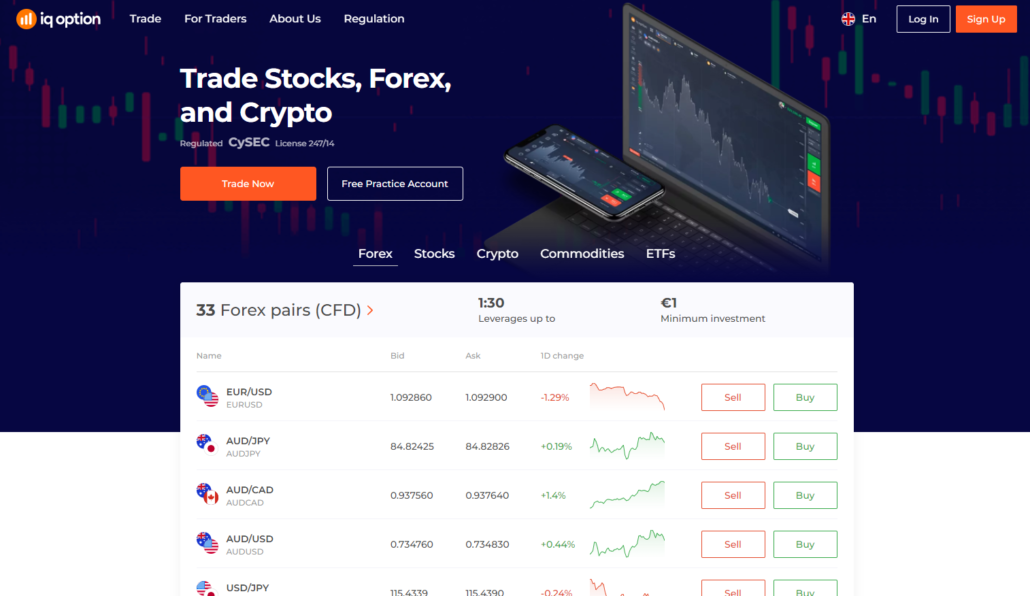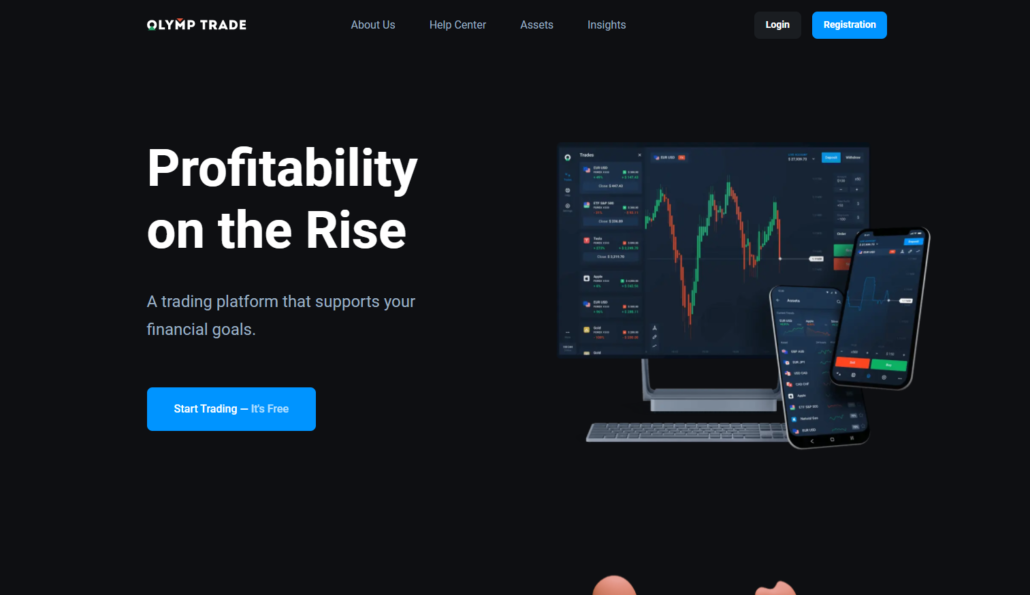Antigua and Barbuda are small islands in the Caribbean. You can find them on a map between Brazil and the USA. Binary Options is famous because of how simple it is to trade. Today, more and more people are starting to go into this type of financial market. If you’re in the Antigua and Barbuda Islands thinking about starting Binary Options, but you’re finding it hard to know which binary options broker is best for you, then this article has you covered. Here is all you need to know about binary trading as an Antiguan.

Here are the five best Binary Options brokers to trade with in Antigua and Barbuda:
See the best 5 Binary Options brokers in Antigua and Barbuda:
100+ Markets
- Accepts international clients
- High payouts 95%+
- Professional platform
- Fast deposits
- Social Trading
- Free bonuses
100+ Markets
- Min. deposit $10
- $10,000 demo
- Professional platform
- High profit up to 95%
- Fast withdrawals
- Signals
300+ Markets
- $10 minimum deposit
- Free demo account
- High return up to 100% (in case of a correct prediction)
- The platform is easy to use
- 24/7 support
100+ Markets
- Professional platform
- Free demo account
- $10 minimum deposit
- Webinars and education
- High payouts
100+ Markets
- Accepts international clients
- High payouts 95%+
- Professional platform
- Fast deposits
- Social Trading
- Free bonuses
from $50
(Risk warning: Trading is risky)
100+ Markets
- Min. deposit $10
- $10,000 demo
- Professional platform
- High profit up to 95%
- Fast withdrawals
- Signals
from $10
(Risk warning: Trading is risky)
300+ Markets
- $10 minimum deposit
- Free demo account
- High return up to 100% (in case of a correct prediction)
- The platform is easy to use
- 24/7 support
from $10
(Risk warning: Your capital might be at risk)
100+ Markets
- Professional platform
- Free demo account
- $10 minimum deposit
- Webinars and education
- High payouts
from $10
(Risk warning: Trading is risky)
What you will read in this Post
List of the 5 best Binary brokers in Antigua and Barbuda
Generally, there are many suitable brokers all over the world. With so many options, it’s hard to keep an overview. Therefore, we have chosen the best ones for you. So, let’s find out more about the best binary brokers in Antigua and Barbuda.
#1. Quotex
Quotex is a commission-free binary broker that trades Binary Options to several European countries and other countries. The company has its main office in the United Kingdom. Quotex is well-known because though it started in 2019, it already has so many traders on the platform and gives many instruments to trade with.

Quotex traders have to deposit at least $10 before trading on the platform. The platform is WebTrader-based. Traders can as well trade using the mobile app version. The broker has a training account, known as a demo account which proves helpful for many new traders who want to get a feel of Binary Options before using a real account.
Features:
- Initial deposit: $10
- Instruments: forex, stocks, metals, energies
- Platform: app, web
- Support: 24 hours/7 days
- Leverage: 1:500
- Bonus: No bonus
Is Quotex legal in Antigua and Barbuda?
Indeed, binary options trading through Quotex is entirely within the bounds of the law and legal to use in Antigua and Barbuda. The absence of specific regulations pertaining to online binary options trading in Antigua and Barbuda does not deem it illegal.
(Risk warning: You capital can be at risk)
#2. IQ Option
Everyone knows IQ Option as a Forex broker, but it also is a Binary Options broker. The company initially started by providing Binary Options services to its clients since its establishment in 2013. The broker is based in Cyprus and is even an award-winning broker. IQ Option has many tradable instruments traders can use.

The platform is self-made by the owner’s IQ Option and is sometimes compared with the MT4 platform. The platform is interactive and customizable by traders. The demo account is already loaded with $10000 for new and old traders to use for practicing purposes.
Trading Binary Options on the platform is straightforward for even new traders.
Features:
- Initial deposit: $10
- Instruments: OTC, stocks, currencies, EFT.
- Platform: Mobile app
- Support: 24 hours/7 days
- Leverage: 1:500
- Bonus: No bonus
Is IQ Option legal in Antigua and Barbuda?
IQ Option is a legal and prominent binary options broker in Antigua and Barbuda, serving thousands of active traders and holding over 10% market share due to its unique features. Antigua and Barbuda citizens enjoy competitive trading terms and advanced technology without any extra privileges.
(Risk warning: You capital can be at risk)
#3. Pocket Option
Pocket Option offers more than 100 instruments for traders to use and is known to be a user-friendly broker’s platform. The broker is known to accept traders from more than 95 countries today. It was set up to provide Binary Options in 2017, with its headquarters in the Marshall Island in Europe.

If you want to start trading on Pocket Option, you need to deposit at least $50. The platform is MT5-based and mobile app-based. As a trader on Pocket Option, you will enjoy some premium bonuses on Pocket Option. The platform is available for both desktop owners and smartphone users.
Features:
- Initial deposit: $50
- Instruments: Stocks, Forex, currencies, commodities
- Platform: MetaTrader 5
- Support: 24hours/7days
- Leverage: 1:100
- Bonus: Welcome, trader’s union, cash return, promo code
Is Pocket Option legal in Antigua and Barbuda?
Yes, Pocket Option is a legal and renowned trading firm active in Antigua and Barbuda, gaining recognition for its exceptional services and increasing popularity among the country’s traders. Presently, there are no explicit regulations deeming online binary options trading in Antigua and Barbuda as unlawful.
(Risk warning: You capital can be at risk)
#4. Olymp Trade
Olymp Trade is a popular Binary Options broker that was founded in 2014. The broker had its main office in St. Vincent & the Grenadines. Offering many tradable instruments, the broker has many traders that patronize it from different countries. Olymp Trade has support that offers more than eight languages, making the broker attract more customers.

It is very easy to open a trader’s account on the platform whether you are using the mobile app or the desktop web version. As a trader, you need to make an initial deposit of $10, after which you can start placing trades in the market. Olymp Trade has its platform, this platform is very easy for traders to use.
Features:
- Initial deposit: $10
- Instruments: CFDs, OTCs, stocks, metals
- Platform: Binomo
- Support: 24hours/7days
- Leverage: 1:500
- Bonus: No bonus
Is Olymp Trade legal in Antigua and Barbuda?
Certainly, Olymp Trade is a legitimate trading platform that presents many benefits to traders worldwide, including those hailing from Antigua and Barbuda. As an integral aspect of its dedication to combat fraud and money laundering, the platform diligently conducts comprehensive background checks on all its traders.
(Risk warning: You capital can be at risk)
How to Sign up for Binary Options in Antigua and Barbuda
The good thing is that the information you will need to provide while signing up is nothing new to most people. As a citizen in Antigua and Barbuda, you must have come across an app or website that requires this information that the Binary Options broker will make use of to open your account.

The first process that will be required when registering is to enter your email and provide a password which you will be able to use in case you log out of the website or app. After inputting your email and password, the broker will need you to confirm your account from your mail.

After confirmation, to complete your registration process, you will need to provide a means of identifying who you are. This can be done by taking a picture of your national passport or driver’s license. Whichever you prefer. After identification, you will need to submit a proof of location or a picture of your bank statement or utility bill.
Creating an account for you from the broker’s end should take at least a day before you will be confirmed to start trading on the platform. If your account has not been successfully created within a day, know that it could be because of a problem with one of the documents you submitted. You can proceed to check your mail to know what the problem is.
(Risk warning: You capital can be at risk)
Is Binary Options trading legal in Antigua and Barbuda?
Yes, traders from Antigua and Barbuda can trade Binary Options in the country. There is no limitation to trading Binary Options. No framework is responsible for how Binary Options transaction is to be conducted in the country and so many traders from this Island find it hard to know which broker is best to trade on.
To trade Binary Options in Antigua and Barbuda, traders should make sure that they are trading with brokers that have licenses (s) from international financial regulators. Those kinds of brokers are legit and can be accounted for.
Get a free deposit bonus of 50% at Quotex with our promotion code “bobroker50“
You can only use this bonus code by signing up via our website.
(Risk warning: Trading involves risks)
Financial Regulation in Antigua and Barbuda
Financial regulation in the Islands of Antigua and Barbuda is the duty of the Financial Services Regulatory Commission. The FSRC is the organization in charge of regulating all financial institutions in the country.

The duties include licensing, supervision, and punishment of any financial institution that does not follow the laws set by the commission. The FSRC is also in charge of controlling securities and exchange in the country.
(Risk warning: You capital can be at risk)
How to deposit funds for Binary Options trading
Funding your account for Binary Options on any broker takes simple steps. Right from your comfort zone, you can credit your account and start trading on your live account.

To fund your account, you need to select the payment method you will like to use to credit your trading account. Payment methods are used to help traders to load their trading accounts through various means. These means include depositing money from your bank. This is called direct bank transfer. If you do not wish to use any card, you may use this method.

Another method is through the use of cards. By cards, this means your debit or credit card. Debit and credit cards are usually powered by Mastercard or Visa, so be sure to check which kind of card the broker supports.

You may also make deposits from your e-wallet. This is a fast means to load your Binary Options trading profile.
Aside from the payment method, brokers have a minimum amount that you as a trader can deposit. This means that you cannot fund your account with anything less than the stipulated minimum amount.
(Risk warning: You capital can be at risk)
How to Withdraw
Withdrawal is just as easy as funding your account. The difference is that this time you are removing money from your trading account. This can be done by selecting a withdrawal method. The broker will provide you with different methods you can choose from.

If you want to withdraw funds from your trading account into your bank, you have to select the option that says directly into your bank account. Once you confirm the bank account, an OTP or token pin will be sent to the phone number you used to register. After confirming the OTP or token pin, the broker will need some time to process the payment into your bank account.
(Risk warning: You capital can be at risk)
You may also select another method like the money you are withdrawing should be sent into your e-wallet, if you have any. This method may also take some time before the money will reflect in the wallet.

How to Trade Binary Options
One thing you need to know is that Binary Options are one of the simplest trades that can be done. If you are a citizen of Antigua and Barbuda who has been considering starting Binary Options, but do not know how to trade, then just follow the steps below after you have opened an account with a broker.

Step #1: Examine how the market trends move
There’s a reason why this is the first step you need to take if you want to trade Binary Options in your country or anywhere else. Examining market trends is useful because it helps you to take note of how the market works. You will know what time market prices go high and what time it comes low.

Examining market trends helps traders know when to place a trade. The right time and right place. After you have done this, then you can move to the next step which is selecting your market.
(Risk warning: You capital can be at risk)
Step #2: Market preference
Market preference is what makes you choose the market you are trading in on the platform.
- Trade duration

This depends on how long you like to trade or how you see the market movement. You may like to trade in days or weeks. Whatever trade duration you prefer will help you choose your market.
- Your interest
Selecting a market according to your interest means that you choose a market according to how something you like makes you pick the market. For example, choosing a market because of an instrument.
Step #3: Choose a price and ending time
This means you select a price you want to trade with. The price you can place a trade with depends on the broker. After choosing a price, you can then set the time you want the trade to close.
Step #4: Place trade
Once you have set a price and end time, you can proceed to place a trade on the chart.

Step #5: Exit trade or stay and wait till it ends
After placing a trade, you should monitor it closely. Binary Options are a fast trade and it has high risk. If after placing a trade and your trading position seems to be going well at first, it can change drastically in a matter of milliseconds.

Keeping a careful eye on it will help you to know if you should exit the trade or wait for it to end.
Conclusion: Binary Options brokers are available in Antigua and Barbuda
Trading in Binary Options can be really fun and seem easy. It is true that it is easy but is a risky market too. Binary Options traders always keep an eye on their trade. This is a good thing, because of the risk involved in trading Binary Options.
As a trader from Antigua and Barbuda, you might want to do the same when trading Binary Options.
Frequently Asked Questions (FAQs) about Binary Options in Antigua and Barbuda:
Is binary trading legal in Antigua and Barbuda?
Yes, within Antigua and Barbuda, binary options hold legal status. However, it’s imperative for traders to opt for a trusted broker and consult our guide on sidestepping fraudulent schemes.
How much money do you need in Antigua and Barbuda to trade binary options?
The level of investment you allocate to binary options generally depends on your comfort with risk, your objectives in trading, and the minimum deposit specified by the particular binary options broker you choose. Typically, you can open an account with just $10 and start trading from $1.
What are common payment methods for binary options brokers in Antigua and Barbuda?
You have several options for making deposits and withdrawals, including utilizing major credit and debit cards, conducting bank wire transfers, or utilizing a variety of e-wallets such as iDEAL, Neteller, Sofort, Rapid Transfer, Trustly, Skrill, GiroPay, Multibanco, and P24.
What are the risks of binary trading options in Antigua and Barbuda?
Engaging in binary options trading in Antigua and Barbuda carries substantial risks. This stems from its speculative essence, which offers a high potential for financial loss. The lack of well-defined regulation in this domain can expose traders to fraudulent activities.
Can you trade binary options for free in Antigua and Barbuda?
Engaging in binary options trading invariably entails a level of financial exposure, and it’s typically not a cost-free endeavor, whether in Antigua and Barbuda or any other location. Traders endeavor to forecast fluctuations in asset prices, with gains or losses hinging on the precision of these predictions.
Can I profit from binary options trading in Antigua and Barbuda?
Profitability in binary options trading is not guaranteed anywhere, including Antigua and Barbuda. It is a high-risk trading activity, and whether you profit or not depends on your skills, strategies, and market conditions. Approach binary options trading with caution and a deep understanding of the risks, as many traders incur losses.
Is it possible to earn a livelihood through binary trading in Antigua and Barbuda?
Binary trading can yield substantial profits with its simpler and faster approach compared to traditional forex trading. While it offers the opportunity to generate significant returns in a short timeframe, it also carries the risk of substantial losses within that same brief period.
(Risk warning: You capital can be at risk)








